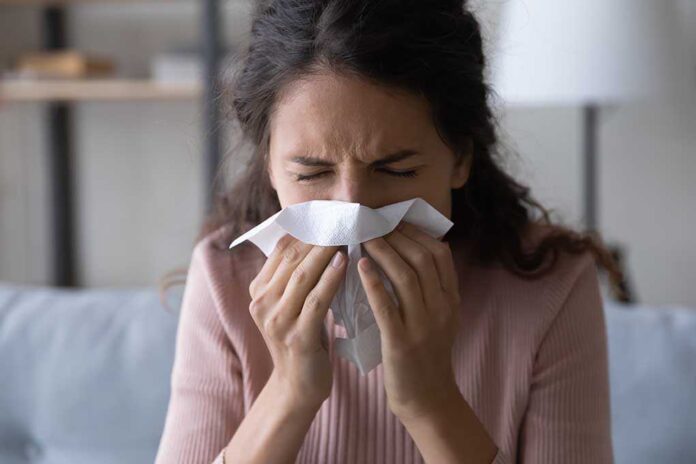
Wichita, Kansas, claims the unfortunate title of “Allergy Capital of the U.S.” for the third consecutive year, while millions of Americans prepare for what could be a particularly challenging 2025 allergy season with extended pollen seasons and increasing symptom severity.
At a Glance
- Wichita, Kansas ranks as the top U.S. allergy capital for the third straight year, with New Orleans jumping from 34th to 2nd place in 2025
- Climate change is extending allergy seasons, with some sufferers now experiencing symptoms almost year-round
- Effective management strategies include tracking pollen counts, using appropriate medications, and reducing indoor allergen exposure
- Allergic asthma triggered by seasonal allergies can be life-threatening, with approximately 10 people dying from asthma daily
Understanding America’s Allergy Capitals
The Asthma and Allergy Foundation of America (AAFA) recently released its annual “Allergy Capitals” report, identifying the 20 most challenging U.S. cities for allergy sufferers in 2025. This comprehensive analysis examines factors including pollen scores for trees, grasses, and weeds, over-the-counter medication usage, and the availability of local allergy specialists. For many of the over 100 million Americans who suffer from allergies annually, this information provides crucial guidance for preparation and management.
“This year’s report named Wichita, Kansas, as the top 2025 Allergy Capital for the third year in a row due to its: – Worse-than-average tree and grass pollen – Worse-than-average allergy medicine use – Worse-than-average number of board-certified allergists/immunologists,” notes the Asthma and Allergy Foundation of America.
Notably, New Orleans experienced a dramatic leap from 34th to 2nd place, primarily due to a severe weed pollen season exacerbated by Hurricane Francine and unusually warm temperatures. The southeastern United States features prominently on the list, with its environmental conditions creating ideal circumstances for high pollen counts. Additionally, eight California cities saw significant upward movement in the rankings, attributed to increased grass and weed pollen levels following wet weather patterns in 2024.
Climate Change Extends Allergy Seasons
A concerning trend emerges from the data: allergy seasons are growing longer and more severe. Warmer temperatures associated with climate change are increasing both pollen production and air pollution levels. This combination is creating a perfect storm for allergy sufferers, with many experiencing symptoms for extended periods. The traditional winter reprieve from allergies is becoming shorter, leaving some individuals with nearly year-round symptoms.
“Unfortunately, every year pollen counts seem to be getting worse, and that’s largely related to global warming,” explains Dr. Payel Gupta, MD, according to Everyday Health.
The traditional pollen calendar follows three primary waves: tree pollen (February-April), grass pollen (April-July), and weed pollen (August until the first frost). However, these periods are becoming less predictable and more prolonged. Adding to the concern, these environmental changes are causing some individuals who previously had no allergies to develop new sensitivities.
“Changes in temperature and precipitation patterns allow plants and trees to grow in places they didn’t before,” reports the American Lung Association, as noted by Fox News.
Management Strategies for Allergy Sufferers
For those dealing with seasonal allergies, understanding specific triggers is the crucial first step toward effective management. While regional variations exist in pollen types and concentrations, no area is completely immune. Consulting with an allergy specialist can help identify personal triggers and develop a tailored management plan, particularly important for individuals with allergic asthma, which can have serious health implications.
“There’s something called allergic asthma, which is asthma that’s triggered by seasonal allergies. What a lot of people don’t realize is that 10 people die each day from asthma, so it’s really important to have your allergies under control if you have allergic asthma,” emphasizes Kenneth Mendez, according to Border Report.
Practical management approaches include tracking local pollen counts to plan outdoor activities, using appropriate medications proactively rather than reactively, and implementing strategies to reduce allergen exposure. Over-the-counter antihistamines and nasal sprays can provide significant relief when used correctly. For those with more severe symptoms, immunotherapy treatments may offer longer-term solutions.
Creating an Allergy-Friendly Home Environment
While outdoor allergens may seem unavoidable, creating a healthier indoor environment can significantly reduce overall symptom burden. Simple measures include keeping windows closed during high pollen periods (especially mornings), changing clothes after outdoor activities, and using air purifiers with HEPA filters. Controlling indoor humidity levels with dehumidifiers can help prevent mold growth, another common allergen that can exacerbate respiratory symptoms.
“One of the most important things that we recommend is to use a 24-hour antihistamine, because they’re longer-acting and can really help control symptoms,” advises Dr. Purvi Parikh, according to Fox News.
Regular cleaning practices targeting dust accumulation, prompt addressing of any water leaks, and proactive inspections for mold in bathrooms, kitchens, and basements can further improve indoor air quality. For those living in high-ranking allergy capitals, these indoor environment modifications become even more crucial for maintaining comfort and health during peak allergy seasons.
Preparing for the 2025 Allergy Season
As the 2025 allergy season approaches, being proactive rather than reactive offers the best chance for symptom control. Monitoring pollen forecasts, starting medications before symptoms appear, and consulting with healthcare providers about personalized strategies can significantly improve quality of life. This preparation is particularly important for residents of identified allergy capitals, where environmental conditions create heightened risks for sensitive individuals.
“Every region in the country is going to have its own unique, challenging pollen, but there are plants everywhere, and those pollens can travel hundreds of miles, so there’s really no safe place to be when it comes to seasonal allergies,” states Dr. Christopher Codispoti, MD, according to Everyday Health.
While seasonal allergies remain a significant challenge for millions of Americans, understanding the patterns, triggers, and effective management strategies can transform the experience from debilitating to manageable. With climate changes continuing to impact pollen production and distribution, staying informed about local conditions and adapting personal practices accordingly will be increasingly important for maintaining respiratory health and overall quality of life.


 News Editor
News Editor




























